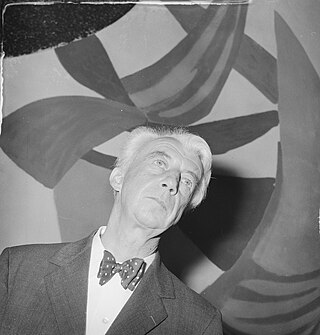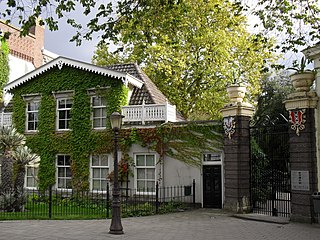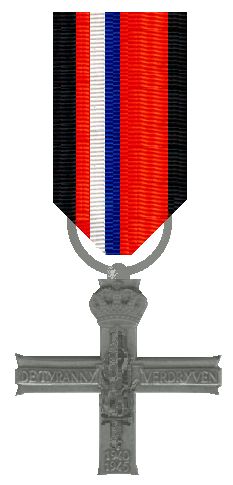
Willem Johan Cornelis Arondéus was a Dutch artist and author who joined the Dutch anti-Nazi resistance movement during World War II. He participated in the bombing of the Amsterdam public records office to hinder the Nazi German effort to identify Dutch Jews and others wanted by the Gestapo. Arondéus was caught and executed soon after his arrest. Yad Vashem recognized Arondéus as Righteous Among the Nations.

Frieda Belinfante was a Dutch cellist, philharmonic conductor, a prominent lesbian, and a member of the Dutch resistance during World War II. After the war, Belinfante emigrated to the United States and continued her career in music. She was the founding artistic director and conductor of the Orange County Philharmonic.

The Dutch resistance to the German occupation of the Netherlands during World War II can be mainly characterized as non-violent. The primary organizers were the Communist Party, churches, and independent groups. Over 300,000 people were hidden from German authorities in the autumn of 1944 by 60,000 to 200,000 illegal landlords and caretakers. These activities were tolerated knowingly by some one million people, including a few individuals among German occupiers and military.

Leopold "Leo" Smit was a Dutch composer, murdered during The Holocaust at the Sobibor extermination camp.

Karl Gröger was a member of a Dutch resistance group executed in 1943.

Jonkheer Willem Jacob Henri Berend Sandberg known as Willem Sandberg was a Dutch typographer, museum curator, and member of the Dutch resistance during World War II.

Gerrit van der Veen was a Dutch sculptor. He was a member of the Dutch underground, which resisted the German occupation of Amsterdam during World War II. The historian Robert-Jan van Pelt wrote:
In 1940, after the German occupation, van der Veen was one of the few who refused to sign the so-called “Arierverklaring,” the Declaration of Aryan Ancestry. In the years that followed, he tried to help Jews both in practical and symbolic ways. Together with the musician Jan van Gilse and the artist, art historian, and critic Willem Arondeus, van der Veen established the underground organization De Vrije Kunstenaar. Van der Veen and the other artists published a newsletter calling for resistance against the occupation. When the Germans introduced identity documents (Persoonsbewijzen) that distinguished between Jews and non-Jews, van der Veen, Arondeus and the printer Frans Duwaer produced some 80,000 false identity papers.

Plantage is a neighbourhood of Amsterdam, Netherlands located in its Centrum borough. It is bordered by the Entrepotdok to the north, Plantage Muidergracht to the east and south and Nieuwe Herengracht to the west. In the centre of the neighbourhood lies the Natura Artis Magistra zoo. It had a population of 1,980 in 2017.

Johan Willem van Hulst was a Dutch school director, university professor, author, politician, chess player and centenarian. In 1943, with the help of the Dutch resistance and students of the nearby University of Amsterdam, he was instrumental in saving over 600 Jewish children from the nursery of the Hollandsche Schouwburg who were destined for deportation to Nazi concentration camps. For his humanitarian actions he received the Yad Vashem distinction Righteous Among the Nations from the State of Israel in 1973.

The Resistance Memorial Cross or Resistance Commemorative Cross is a medal awarded in the Netherlands to members of the Dutch resistance during the Second World War.

Jurjentje Aukes Rauwerda, later Jurrentje Weinthal, was a Dutch prostitute and procurer. She was famous among members of her profession in the contemporary Netherlands, and ran the largest brothel in Amsterdam, the Maison Weinthal.

The Erebegraafplaats Bloemendaal, or Dutch Honorary Cemetery Bloemendaal, is a World War II final resting place in Zuid-Kennemerland National Park in Bloemendaal, Netherlands. Located on the top of a dune, it can be reached by a small path from a parking lot located near the provincial route between Overveen center and Zandvoort.
Hans Renders is a professor of history and biography theory at the University of Groningen. Since 2004, he is also the head of the university's "Biography Institute".

Helena Suzanna van Hall was a Dutch dancer.
Riphagen: The Untouchable is a 2016 Dutch drama film about Dries Riphagen, a Dutch criminal who collaborated with Nazi Germany.

Laura "Lau" Carola Mazirel was a member of the Dutch resistance during World War II who helped organise the 1943 bombing of the Amsterdam civil registry office. An attorney, she was an early proponent of LGBT rights and the rights of Romani people. She opposed civil marriage due to the then-inferior status of women, and also opposed registration of personal information, which she considered a violation of privacy.
Events in the year 1944 in the Netherlands.
Events in the year 1945 in the Netherlands.

Johannes Post was a Dutch resistance leader during the Nazi occupation of the Netherlands. He helped lead part of the Landelijke Knokploegen and hid Jews in his village, Nieuwlande. Post was recognized as Righteous Among the Nations in 1965.
Stephen Fry: Willem & Frieda – Defying the Nazis is a 2023 Channel 4 documentary film presented by Stephen Fry and directed by John Hay. It is about two gay members of the Dutch resistance during the Second World War, Willem Arondeus and Frieda Belinfante.






















